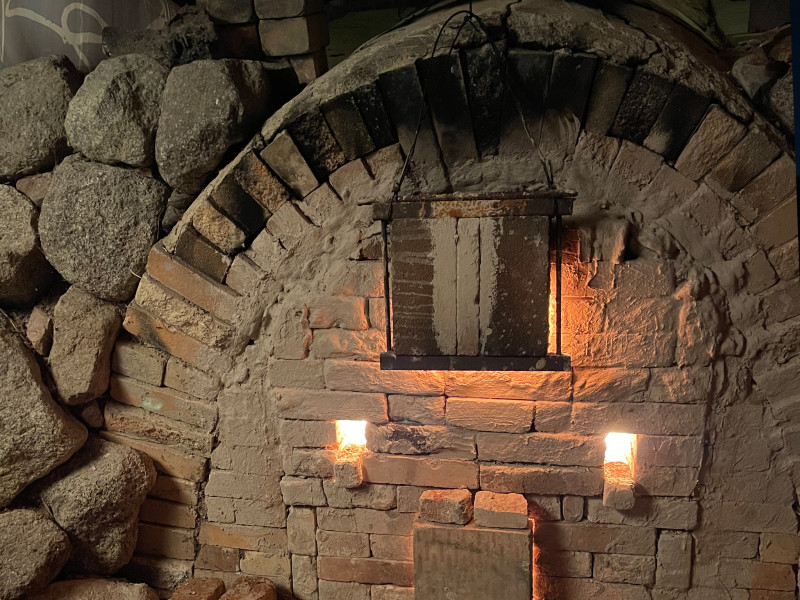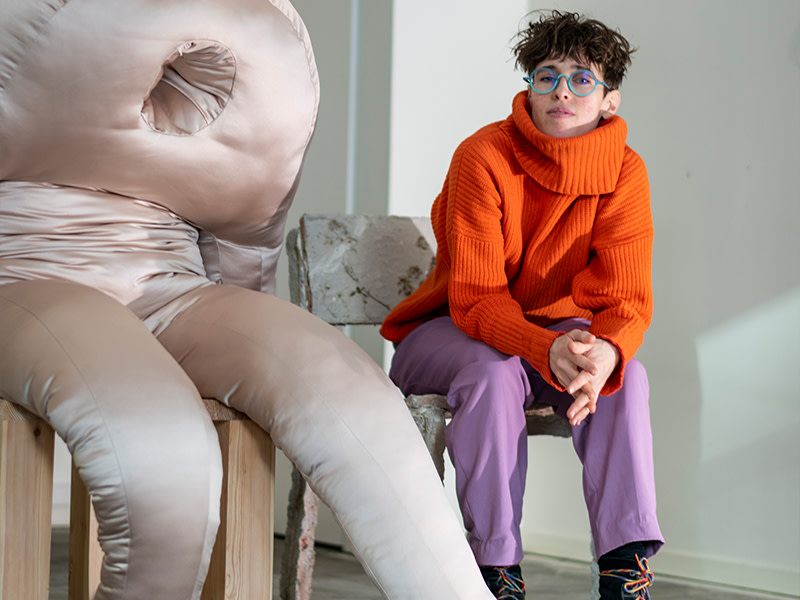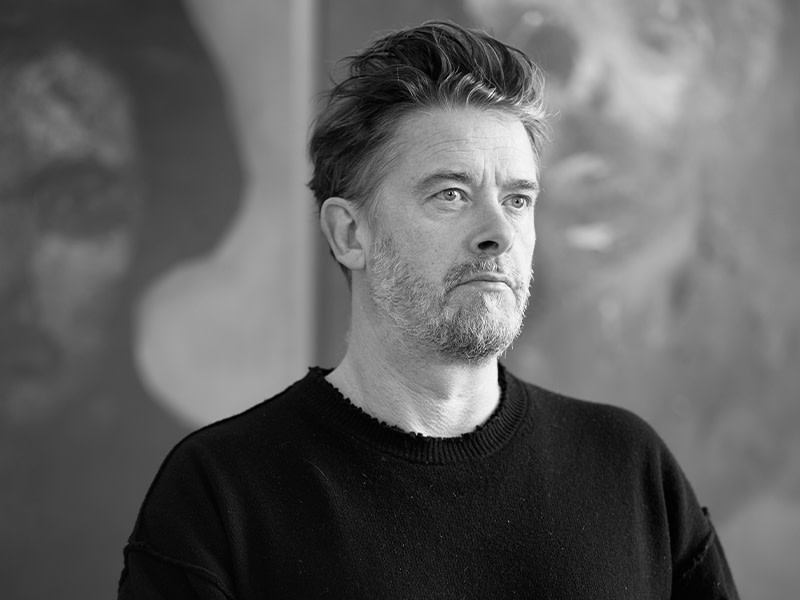In conversation with Isak Hall by Michael Storåkers
Interview
March 17, 2024
How would you describe the emotional and artistic theme in your previous series, such as ‘Northern Transcendence,’ ‘Temple Series,’ and ‘Atlas,’ and how is this reflected as a narrative (if you want to call it that) in your new exhibition?
— For me, it’s really about one single series that is ongoing, which constitutes my own atlas. Each new exhibition could be considered a new chapter in my atlas. The atlas never gets finished but is constantly changing and evolving. The main theme in my art, I imagine, is the attempt to create something that exists beyond narratives, beyond time and space. That’s exactly where I want my art to be: outside of time and space.
Can you share some insights about the novelty in the technique you’re using, especially considering your blend of pigments and binders to achieve the desired lustre and expression?
— Even though I want my works to exist beyond time and space, I like to wander backward in time to be able to change and evolve. In the recent paintings, Max Doerner’s book ‘The Materials of the Artist and Their Use in Painting’ from 1921 has served as inspiration. Also, Theodore de Mayerne’s manuscript from the seventeenth century has been very useful. Mayerne interviewed about fifty artists, including some of the Flemish masters, about their techniques. The manuscript contains recipes for painting mediums, varnishes, and glazes, even recipes attributed to Leonardo da Vinci.
Anyway, I’ve used two new egg-oil tempera emulsions, tempera grass and tempera damar, for underpaintings. For glazes and varnishes, I’ve also used new recipes, some from Mayerne’s manuscript. Otherwise, I buy a lot of my materials from Dr. Georg Kremer. For the latest paintings, I’ve also used ultramarine ash, a by-product from the production of the pigment lapis lazuli. The ash is used for underpainting the areas that are then painted with lapis lazuli. The result is a special grey lustre, I believe you can see it in, among others, Dürer’s paintings.
For the new paintings, I’ve also used a special glaze that is said to have been used by the van Eyck brothers. Those are some of the historical traces in my works. The new is actually very old. Then, of course, the painting itself is an activity that evolves as it is practiced; that knowledge exists beyond the books.
Previously, you painted pictures in the same size as René Magritte’s ‘The Empire of Light.’ We’ve heard that you’re using different sizes now – a larger scale as well as several watercolours that are your ‘sketches.’ What can you say about the idea behind this larger motif you’ve developed this time?
— I sketch and paint watercolours in smaller formats; they often form the basis for the larger paintings. Some of the paintings in the ‘Fatamorgana’ exhibition have the same dimensions as Magritte’s work, where dark night and illuminated day coexist. Other dimensions I’ve borrowed from other historical paintings, ranging from works by Bruno Liljefors to the Swiss Arnold Böcklin. It’s about traces and references, I have noticed.
Regarding the larger size, I was supposed to exhibit two paintings in Uppsala Cathedral at the end of 2023 – but only managed to finish one of them. ‘The Abyss’ is shown for the first time at this exhibition, along with the painting exhibited in the cathedral. The dimensions of the paintings are adapted to the cathedral. By the way, indigo is the most prominent pigment in ‘The Abyss.’ It’s a pigment with a dark history; when it became popular in Europe, the slave trade thrived. Then, in the seventeenth century, the organic pigment was replaced by the first synthetically produced pigment, Prussian blue.
The fitting name of your current exhibition at Bror Hjorths Hus, ‘Fatamorgana,’ has a very suitable meaning considering the light, ‘mirage,’ and light prisms one can sense in your works. Your upcoming exhibition at CFHILL doesn’t have a name – how would you describe, or perhaps summarize, this collection of works from ‘Fatamorgana’ and these entirely new works you’re exhibiting at CFHILL?
— ‘Fatamorgana’ means mirages or illusions alternatively dream images. I like the word itself; it’s both hallucinatory and scientific, which is entirely to my taste. ‘Fatamorgana’ also relates to the prismatic properties of various pigments. Several of my recent paintings depict reflections and river landscapes, the dissolution between the earthly and the heavenly world.
The works now exhibited at CFHILL are the cathedral series, that is, the works I created for Uppsala Cathedral, and the ‘Fatamorgana’ series, previously shown at Bror Hjorts Hus. In addition, three new paintings emanated from the painting that wasn’t completed, ‘The Abyss.’ Furthermore, a series of new watercolours and paintings are also exhibited.
The fact that the exhibition has no name might be about me trying not only
to go beyond time and space but also beyond words and designations.
You have historically been very inspired by the techniques and methodologies of Renaissance painters, but your motifs have been your own. Some speak of a sadness, or perhaps melancholy in the colour tones of the paintings. What would you say drives your motifs, where do these images come from? Can there perhaps be a sense of sadness in that these beautiful illusions are fleeting phenomena? (‘What is beautiful is fleeting,’ as the Stoic philosophers said.)
— I don’t personally think my paintings are sad; on the contrary. However, I want them to evoke stillness and contemplation. My paintings often have dawn or twilight light, which are indeed fleeting phenomena. Life is fleeting. There might be something nostalgic in my paintings, rather than sad. When I speak of nostalgia, I mean the attempt to describe a world, or worlds, that no longer exist and are no longer possible.
What has determined the way you work in layers upon layers, following these old techniques, when there are so many ways to paint? We suspect the answer is related to the unique light that these methods contribute to... but how do you view modern techniques, and do you change anything as you develop technically? How do you relate to the techniques?
— If there’s anything I try to achieve, it’s to achieve increased luminosity and chromatic sharpness in my paintings, and for that purpose, layer-painting is superior. As for natural pigments, light is refracted differently in them, with higher luminosity as a result. On the other hand, artificial colours manufactured by the chemical industry are not ‘bad’ per se. Cobalt blue, for example, is one of the best colours, most violet pigments stem from cobalt blue. Impressionism wouldn’t have existed without artificial colours! Furthermore, it’s a common misconception that the old masters didn’t use synthetic pigments. Naples yellow, lead white, and various copper oxides are examples of such pigments.
During my work in the studio, it’s actually more about trying to gain a deeper understanding of the materials. If we’re going to talk about the motifs, they arise during the process itself, while I paint. There are no direct references; they are fantasy images, mirages.
Can you tell us more about how you explore the phenomenon of mirage in your paintings and how it is reflected in your artistry?
— Mirages are not delusions; they are actual physical phenomena due to the refraction and reflection of light rays against the layers of air. It’s about playing with light, darkness, and depth, which is what I constantly investigate when I paint. Only in a figurative sense do mirages involve dream images or what we might call hallucinations. It’s perhaps exactly where I want to be, where hallucinations and pure scientific knowledge meet. Perhaps it’s about transformation itself. Whether apparent or not, I like to believe that various forms of transformations have accompanied me, following my entire journey as a painter.
What role do exclusive mineral pigments, such as malachite and lapis lazuli, play in your artistry, and how do they contribute to the authenticity and value of the works? And while we’re mentioning colour pigments, you often work with subdued shades of yellow, orange, and ochre. What is your relationship to these colours reminiscent of the sun and desert winds, what do the colours mean to you?
— Mineral pigments have become increasingly important to me. Perhaps it’s about what seems to be so desirable for everyone and in all contexts, namely authenticity. Even though I want to move beyond time and space and actual places, the pigments are still components from very specific places: the yellow and red earth pigments are from Andalusia, Morocco, France, or Italy, malachite comes from Congo, and green quartz from Madagascar. In my paintings, the components are woven together and become one. Together, they form an archaic fantasy landscape. It is, as you say, the sun and desert winds of the unknown - at the very least something entirely different from the everyday noise and the world of today.
Lapis lazuli is perhaps uniquely special; it comes from a river valley in Badakhshan, a province in north-eastern Afghanistan. Throughout art history, it has been used in wall paintings in Babylon, by the Flemish masters, and is still used, further into the future.
I’m attracted to the idea that the pigments have a millennia-old history, and are incorporated into the present, into what I do. Some of the pigments I use also come from mineral veins that are no longer mined. This contributes to a feeling of exclusivity, but perhaps even more a sense of transience.
How has the environment influenced your creative process when working on the compositions that will be shown in the exhibition? What does the place you paint in mean to you, and how is this reflected (do you think) in your works?
— My studio is located in the old mental hospital Ulleråker in Uppsala. Gustaf Fröding and Ernst Josephson were some of the more famous patients of the mental hospital. It closed in 1988. I’ve been working there for three years now. The fact that I have access to a large space has been important to me; I’ve been able to work with more and larger paintings simultaneously. Since I started working in this studio, both my art and my life, in general, have gained more structure and form. I’m also inspired by the cultural landscape of Uppland, especially the prehistoric remains, such as Valsgärde and Ottarshögen. Even the medieval churches with their frescoes inspire me. I think, for example, of Vendel’s church, where malachite and iron ochre dominate.
Is there an overarching feeling you want viewers to feel/take away after seeing your works?
— I keep coming back to the desire to go beyond words and designations, the wordless. We live in a time flooded with words and images and opinions. I would like those who observe my paintings to pause, fix their gaze, perhaps lose their footing for a moment, to begin to formulate questions and move beyond the reflection of self. Perhaps you will think about the meaning of time, and ponder whether there are other dimensions, other worlds than those most obvious to us. I also want my art to be comforting, as it is to me.”



